China, a land of ancient wonders, breathtaking landscapes, and vibrant modern cities, beckons travelers with unforgettable experiences.
From the iconic Great Wall snaking across its northern borders to the tranquil canals of Suzhou and the bustling metropolis of Shanghai, China offers a diverse range of attractions that cater to every interest and passion.
Embark on a journey of discovery as we unveil the 15 best places to visit in China. Each is a unique and captivating destination that showcases the country’s rich history, diverse cultures, and natural beauty.
Whether you’re seeking historical immersion, cultural exploration, or natural adventures, these destinations will leave you in awe of China’s vast and varied landscapes and the enduring spirit of its people.
- Recommended BEST Tours in China (FREE Cancellation)
- Recommended BEST Tours in Beijing
- Recommended BEST Tours in Hong Kong
- Recommended BEST Tours in Shanghai
- Recommended Beijing Hotels
- Recommended Hong Kong Hotels
- Recommended Shanghai Hotels
- Cheap Flights, Airline Tickets & Plane Tickets (TRIP.COM)
Number 15: The Summer Palace, Beijing.
Escape the urban clamor of Beijing and find tranquility at the Summer Palace, an imperial retreat that epitomizes Chinese landscape artistry. This UNESCO World Heritage Site, covering nearly 300 hectares, invites you to wander through its sprawling grounds, where serene lakes, ornate pavilions, and verdant hills create a harmonious blend of nature and human ingenuity.

At the heart of the Summer Palace lies Kunming Lake, a vast expanse of water that reflects the surrounding landscape like a mirror. Take a leisurely boat ride across the lake, enjoying the cool breeze and the picturesque views of the surrounding hills. Marvel at the iconic Marble Boat, a two-story structure made entirely of marble that once served as a luxurious imperial barge.
Stroll along the Long Corridor, a marvel of Chinese architecture stretching over 700 meters. This covered walkway is adorned with thousands of intricate paintings depicting scenes from Chinese history, mythology, and literature. Take your time to appreciate the artistry and craftsmanship of these vibrant murals, each telling a story of China’s rich cultural heritage.
Ascend Longevity Hill is the highest point in the Summer Palace, and you’ll be rewarded with panoramic views of the entire complex. From this vantage point, you can see the sprawling lake, the intricate pavilions, and the distant cityscape of Beijing. Explore the many temples and pagodas scattered throughout the hill, each offering a unique perspective on Chinese religious and cultural traditions.
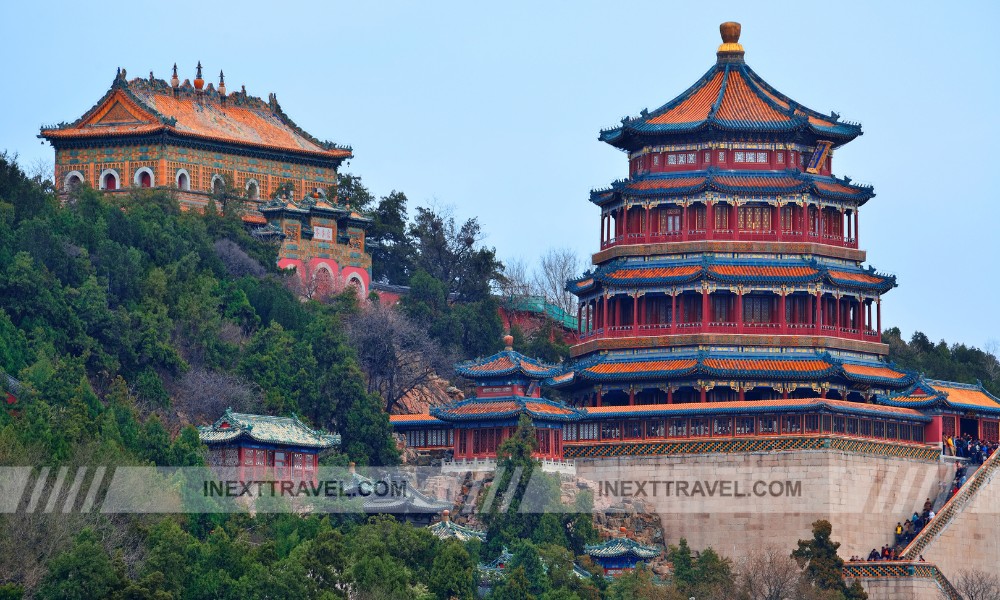
The Summer Palace is more than just a garden; it’s a living testament to China’s imperial past and its profound appreciation for nature’s beauty. Whether you’re seeking tranquility, cultural immersion, or a breathtaking view, the Summer Palace is a must-visit destination that will leave you with a lasting impression of China’s rich heritage.
Number 14: The Forbidden City, Beijing.
Prepare to be transported back in time as we step into the heart of imperial China, the magnificent Forbidden City. This sprawling palace complex, a UNESCO World Heritage Site, was China’s political and cultural center for over five centuries, home to 24 emperors from the Ming and Qing dynasties.
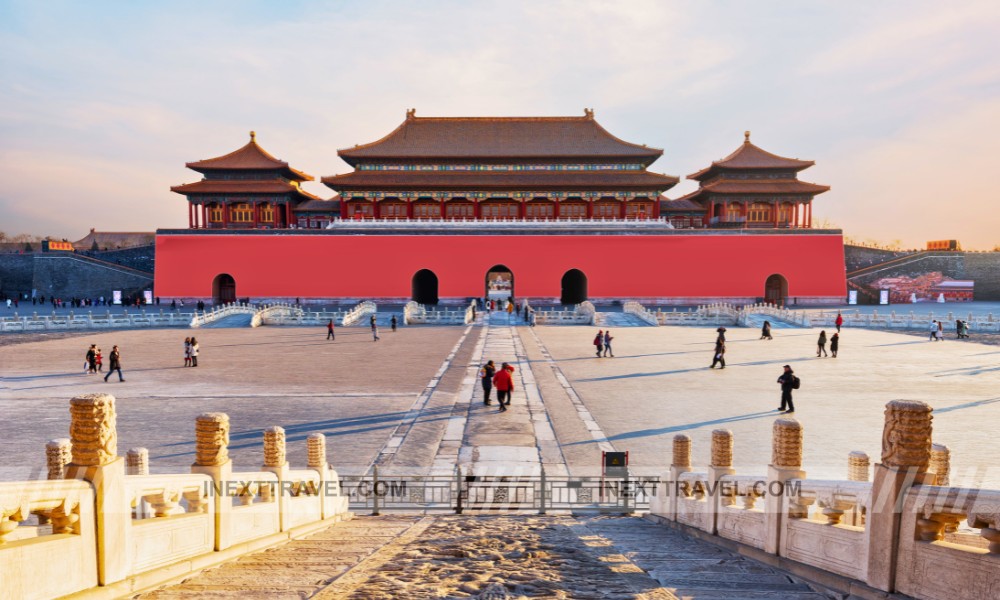
As you enter through the Meridian Gate, the southern entrance to the Forbidden City, you’ll be greeted by a vast expanse of red walls, golden roofs, and intricate courtyards. The sheer scale of the complex is awe-inspiring, a testament to the power and ambition of the Chinese emperors.
Wander through the Hall of Supreme Harmony, the largest wooden structure in China and the symbolic center of the empire. Here, emperors held grand ceremonies and received foreign dignitaries—Marvel at the elaborate throne, the intricate ceiling paintings, and the sheer luxury of the hall.
Explore the Hall of Central Harmony, where the emperor prepared for ceremonies, and the Hall of Preserving Harmony, where banquets and examinations were held. Each hall is a masterpiece of Chinese architecture, with intricate details, colorful decorations, and symbolic elements that reflect the cultural and philosophical beliefs of the time.
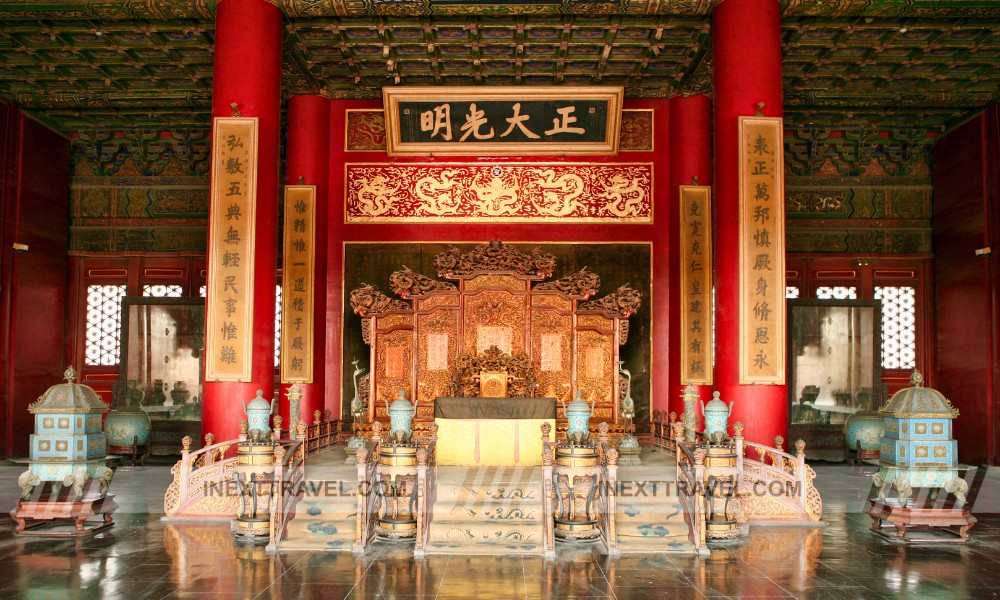
Venture further into the Inner Court, where the emperor and his family resided. Here, you’ll find the Palace of Heavenly Purity, the Hall of Union, and the Palace of Earthly Tranquility, each offering a glimpse into the private lives of the imperial family. Admire the intricate gardens, the tranquil courtyards, and the ornate pavilions that provided a serene escape from the demands of court life.
The Forbidden City is not just a collection of buildings; it’s a living testament to China’s rich history and cultural heritage. As you explore its grand halls, intricate courtyards, and serene gardens, you’ll be transported back to a time of emperors, empresses, and courtly intrigue. It’s a place where the past comes alive, and you can imagine the lives of the people who once inhabited this magnificent palace complex.
Number 13: Li River, Guilin.
Embark on a mesmerizing journey along the Li River, a natural masterpiece that winds through the heart of Guilin’s enchanting karst landscape. This picturesque waterway, often hailed as one of China’s most beautiful, offers a captivating blend of dramatic scenery, tranquil villages, and glimpses into traditional fishing practices.
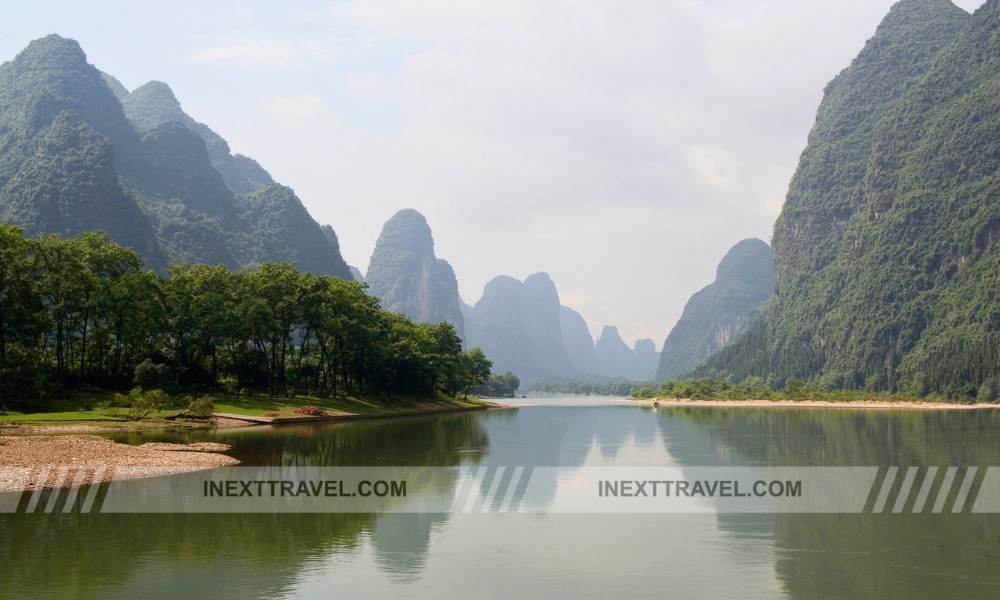
As you cruise the river, you’ll be surrounded by a breathtaking panorama of towering limestone peaks rising majestically from the emerald waters. These karst formations, sculpted by millennia of erosion, create a surreal and otherworldly landscape that has inspired poets, painters, and travelers for centuries. The peaks, often shrouded in mist, evoke a sense of mystery and wonder as if they hide ancient secrets.
The riverbanks are a tapestry of lush greenery, with bamboo forests swaying gently in the breeze and vibrant wildflowers adding color to the landscape. As you glide along the water, you’ll pass by charming villages nestled amidst the karst peaks, their traditional wooden houses, and stone bridges seemingly frozen in time.
Witness the timeless traditions of local fishermen as they cast their nets into the river, their silhouettes reflected in the calm waters. If you’re lucky, you might even witness the ancient art of cormorant fishing, a fascinating practice where fishermen use trained cormorants to catch fish.

The Li River cruise offers a unique perspective on the region’s natural beauty and cultural heritage. As you drift along the water, you’ll feel a sense of tranquility and peace, a chance to connect with nature and appreciate the simple rhythms of life along the river.
Whether you’re a nature lover, a photography enthusiast, or simply seeking a peaceful escape, the Li River cruise is an experience not to be missed. It’s a journey that will awaken your senses, inspire your imagination, and leave you with lasting memories of Guilin’s breathtaking beauty.
Number 12: Yangshuo, Guangxi.
Escape the hustle and bustle of city life and immerse yourself in the tranquil beauty of Yangshuo, a picturesque town nestled amidst a breathtaking karst landscape in Guangxi province. Under towering limestone peaks, meandering rivers, and verdant rice paddies, Yangshuo offers a serene escape where you can reconnect with nature and experience the simple joys of rural life.
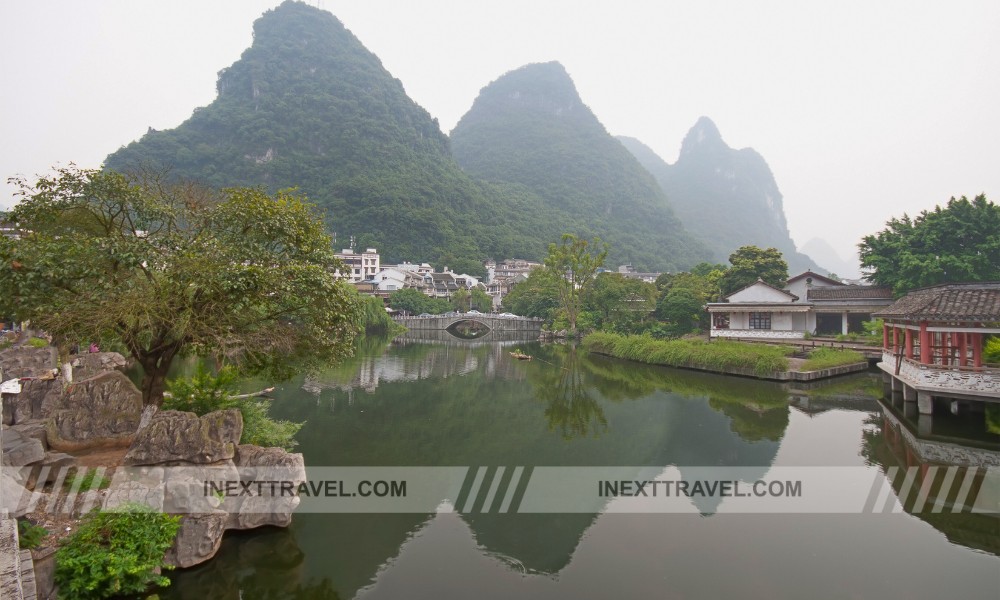
Rent a bicycle and embark on a leisurely ride through the countryside, where you’ll be greeted by stunning scenery at every turn. Pedal along quiet country roads, past farmers tending to their fields, water buffalo grazing in the meadows, and traditional villages where time seems to stand still. Breathe in the fresh air, feel the sun on your face, and let the gentle cycling rhythm soothe your soul.
For those seeking adventure, a hike to the top of Moon Hill is necessary. This iconic limestone peak, with its distinctive moon-shaped arch, offers panoramic views of the surrounding landscape. As you ascend the steep steps, you’ll be rewarded with breathtaking vistas of the karst peaks, the Li River winding through the valley, and the patchwork of rice paddies below.
If you prefer a more relaxed pace, Yangshuo offers plenty of opportunities to unwind and soak up the atmosphere. Stroll along the banks of the Yulong River, rent a bamboo raft, and float leisurely downstream, or find a cozy riverside cafe and enjoy a cup of tea while watching the world go by.
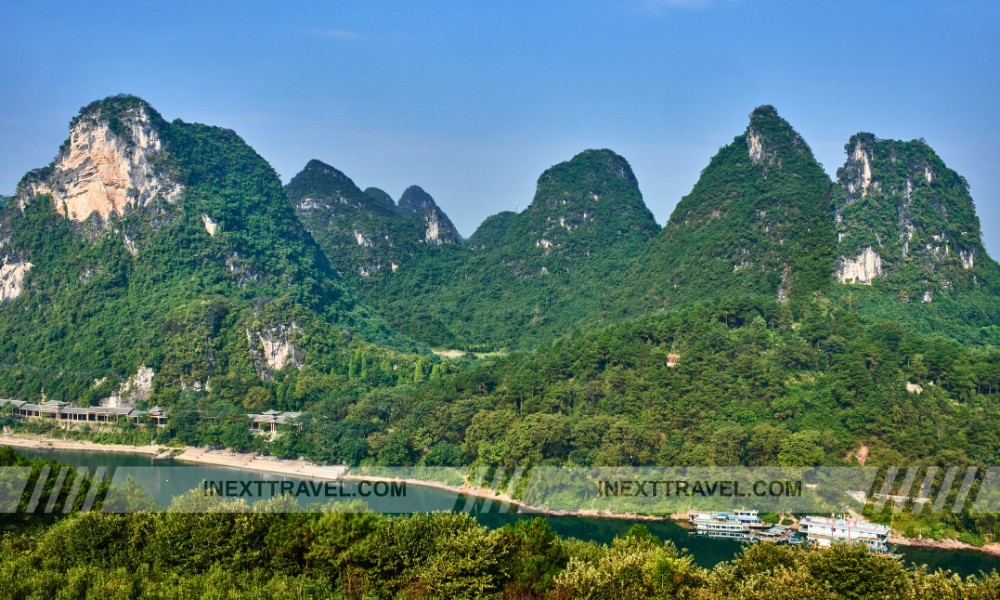
Explore the bustling West Street in the evenings, where you’ll find many shops, restaurants, and bars. Sample local delicacies, browse for souvenirs, or enjoy the lively atmosphere of this famous tourist street.
Yangshuo is a place where you can slow down, reconnect with nature, and experience the simple joys of life. Whether exploring the countryside by bike, hiking to scenic viewpoints, or simply relaxing in a riverside cafe, Yangshuo’s tranquil beauty and laid-back charm will leave a lasting impression.
Number 11: The Bund, Shanghai.
As dusk settles over Shanghai, prepare to be captivated by the dazzling spectacle of the Bund. This iconic waterfront promenade is a true testament to Shanghai’s fascinating blend of history and modernity, where the architectural grandeur of the past meets the vibrant energy of the present.
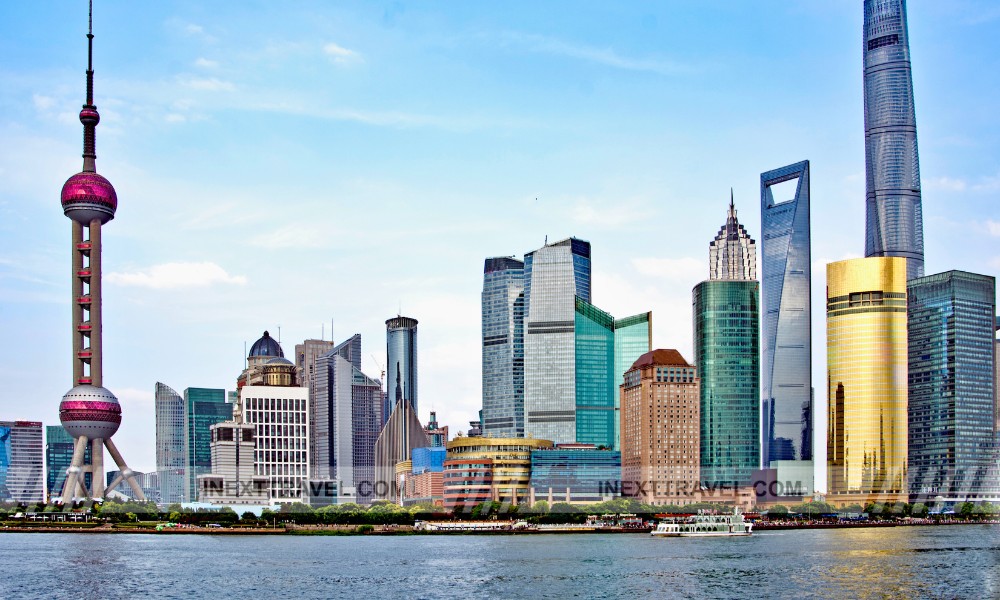
As darkness descends, the Bund’s skyline transforms into a symphony of light. The colonial-era buildings that line the western bank of the Huangpu River, with their ornate facades and Art Deco details, come alive with a golden glow, their reflections shimmering in the water. On the opposite bank, the futuristic skyscrapers of Lujiazui, a testament to Shanghai’s economic prowess, pierce the night sky with their dazzling neon displays.
Stroll along the Bund’s wide promenade and immerse yourself in the lively atmosphere. The air is abuzz with the sounds of street musicians, the laughter of children playing, and the chatter of couples enjoying a romantic evening. Take a moment to appreciate the architectural diversity that lines the waterfront, from the neoclassical grandeur of the HSBC Building to the Art Deco elegance of the Peace Hotel.
The Bund is not just a feast for the eyes; it’s a place where history and culture come alive. Explore the nearby Rockbund Art Museum, housed in a beautifully restored Art Deco building, and discover a collection of contemporary Chinese art. Or, delve into the past at the Shanghai History Museum in the former HSBC Building, which showcases exhibits on the city’s rich history and cultural heritage.

For a truly unforgettable experience, take a Huangpu River cruise and witness the Bund’s dazzling skyline from a different perspective. Gliding along the river, you’ll be treated to a panoramic view of the illuminated buildings, leaving you in awe of Shanghai’s beauty and dynamism.
The Bund is a testament to Shanghai’s enduring spirit and ability to embrace its past and future. It’s a place where you can witness the convergence of history and modernity, where the city’s energy pulsates, and where you can create memories that will last a lifetime.
Number 10: Zhangjiajie National Forest Park, Hunan.
Prepare to enter a real-life Pandora as you enter the otherworldly landscapes of Zhangjiajie National Forest Park. This UNESCO World Heritage Site, renowned as the inspiration behind the floating Hallelujah Mountains in James Cameron’s “Avatar,” boasts a surreal landscape of towering quartz-sandstone pillars, deep ravines, and lush vegetation.

As you wander the park, you’ll feel like you’ve entered a fantastical realm. Hike along winding trails that snake through the towering pillars, some reaching heights of over 200 meters. Admire the unique rock formations, each with its distinct shape and character, and marvel at the intricate patterns etched into the stone by centuries of erosion.
For a truly breathtaking experience, ride on the Bailong Elevator, the world’s tallest outdoor elevator. This glass elevator ascends 326 meters up the side of a cliff, offering stunning views of the surrounding landscape. The ascent is an adventure as you glide past the towering pillars and lush vegetation, feeling the thrill of being suspended mid-air.

If you’re adventurous, test your courage on the Zhangjiajie Grand Canyon Skywalk. This glass-bottomed bridge, the longest and highest of its kind in the world, offers a thrilling perspective on the canyon below. Walk across the transparent walkway, feeling the adrenaline rush as you gaze down at the sheer drop and marvel at the panoramic views of the surrounding mountains and forests.
Zhangjiajie National Forest Park is a nature lover’s paradise, offering endless opportunities for exploration and adventure. Whether hiking through the towering pillars, riding the Bailong Elevator, or testing your courage on the Skywalk, you’ll be captivated by the park’s otherworldly beauty and unique landscape.
Number 9: Jiuzhaigou Valley, Sichuan.
Prepare to be enchanted by the ethereal beauty of Jiuzhaigou Valley, a UNESCO World Heritage site nestled in the heart of Sichuan province. This pristine alpine valley is a nature lover’s paradise, boasting a mesmerizing array of crystal-clear turquoise lakes, cascading waterfalls, and snow-capped peaks that will leave you breathless.

As you venture into this natural wonderland, you’ll be greeted by a symphony of colors. The lakes, known as “Haiti” in Chinese, shimmer in turquoise, emerald, and sapphire shades, their colors changing with the light and the seasons. The waterfalls, some cascading down from towering heights, create a dramatic spectacle of mist and rainbows. And the snow-capped peaks, rising majestically in the distance, provide a breathtaking backdrop to this alpine paradise.
Lace up your hiking boots and explore the valley’s network of well-maintained trails that wind through lush forests, alongside sparkling lakes, and past cascading waterfalls. As you hike, you’ll have the opportunity to encounter various unique wildlife, including the giant panda, the Sichuan golden snub-nosed monkey, and the takin, a rare goat-antelope species.
The valley is also home to several Tibetan villages, where you can experience the rich culture and traditions of the local people. Visit a traditional Tibetan house, sample local cuisine, and learn about the unique customs and beliefs that have shaped this community for centuries.

Whether you’re a nature enthusiast, a wildlife photographer, or a cultural explorer, Jiuzhaigou Valley offers an unforgettable journey into a world of pristine beauty and rich cultural heritage. Its diverse landscapes, unique wildlife, and vibrant Tibetan culture will captivate and inspire you.
Number 8: The Potala Palace, Lhasa.
Prepare to be awestruck by the majesty of the Potala Palace, a towering symbol of Tibetan Buddhism and a UNESCO World Heritage Site. Perched atop Red Mountain in the heart of Lhasa, this architectural wonder was once the winter residence of the Dalai Lamas and remains a pilgrimage site for Buddhists from around the world.

As you approach the palace, its imposing white and red walls, punctuated by golden roofs, dominate the skyline. The sheer scale of the structure is breathtaking, a testament to the power and influence of Tibetan Buddhism.
Step inside the palace and prepare to be transported to a world of intricate artistry and spiritual devotion. The Potala Palace is a labyrinth of chapels, halls, and chambers, each adorned with elaborate murals, sculptures, and thangkas (Tibetan Buddhist paintings). The air is thick with the scent of incense, and the soft glow of butter lamps illuminates the sacred spaces.
Explore the Red Palace, the spiritual heart of the Potala, where you’ll find the tombs of past Dalai Lamas enshrined in gilded stupas. The White Palace, once the living quarters of the Dalai Lama, now houses a museum that showcases a vast collection of artifacts and treasures related to Tibetan Buddhism and culture.
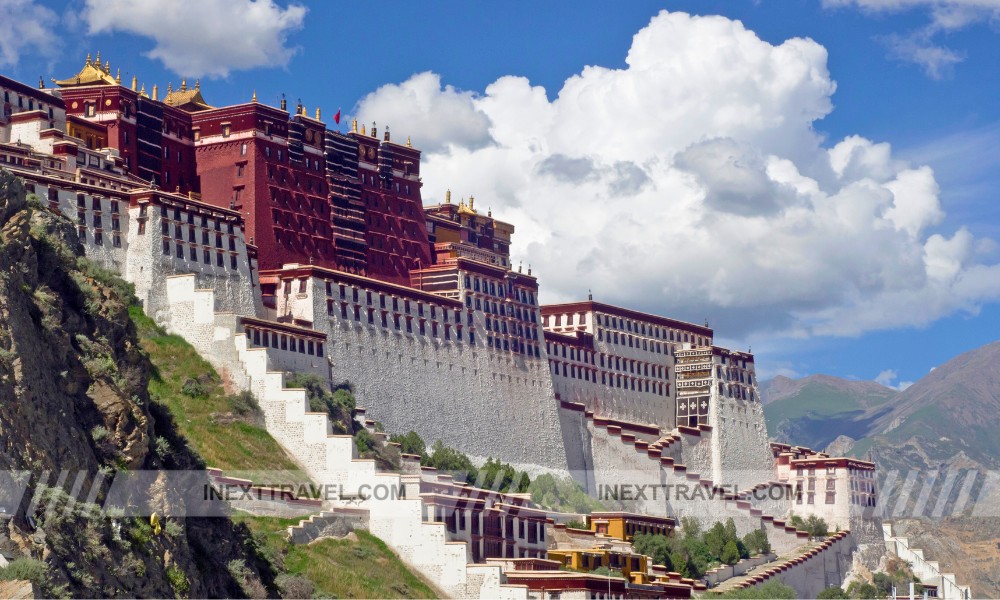
The Potala Palace is not just a museum or a historical monument; it’s a living testament to the enduring power of faith and Tibet’s rich cultural heritage. As you wander through its halls and chambers, you’ll be immersed in the history, spirituality, and artistry of Tibetan Buddhism.
Whether you’re a devout Buddhist, a history enthusiast, or a curious traveler, the Potala Palace is a must-visit destination that will leave you with a profound sense of awe and wonder.
Number 7: The Mogao Caves, Dunhuang.
Embark on a mesmerizing journey through time and art as we delve into the hidden treasures of the Mogao Caves, a UNESCO World Heritage Site near Dunhuang’s oasis. These caves, also known as the “Caves of the Thousand Buddhas,” are a breathtaking testament to the rich history and artistic mastery of China’s Silk Road era.

Carved into the cliffs over a thousand years, the Mogao Caves house a vast collection of Buddhist art, including over 45,000 square meters of murals and more than 2,000 painted sculptures. These intricate works of art depict scenes from Buddhist scriptures, historical events, and everyday life, offering a fascinating window into the time’s culture, beliefs, and artistic traditions.
As you wander through the dimly lit caves, you’ll be amazed by the vibrant colors, delicate details, and sheer scale of the murals and sculptures. Marvel at the graceful figures of bodhisattvas, the serene faces of Buddha, and the intricate patterns of flying apsaras (celestial maidens). Each cave is a unique treasure, offering a glimpse into the artistic expressions of different eras and the evolving styles of Buddhist art.
The Mogao Caves are a repository of art and a testament to the cultural exchange along the Silk Road. The caves served as a major center for Buddhist learning and pilgrimage, attracting monks, scholars, and traders from all over Asia. The murals and sculptures reflect the diverse influences of Indian, Central Asian, and Chinese cultures, creating a unique and eclectic artistic style.
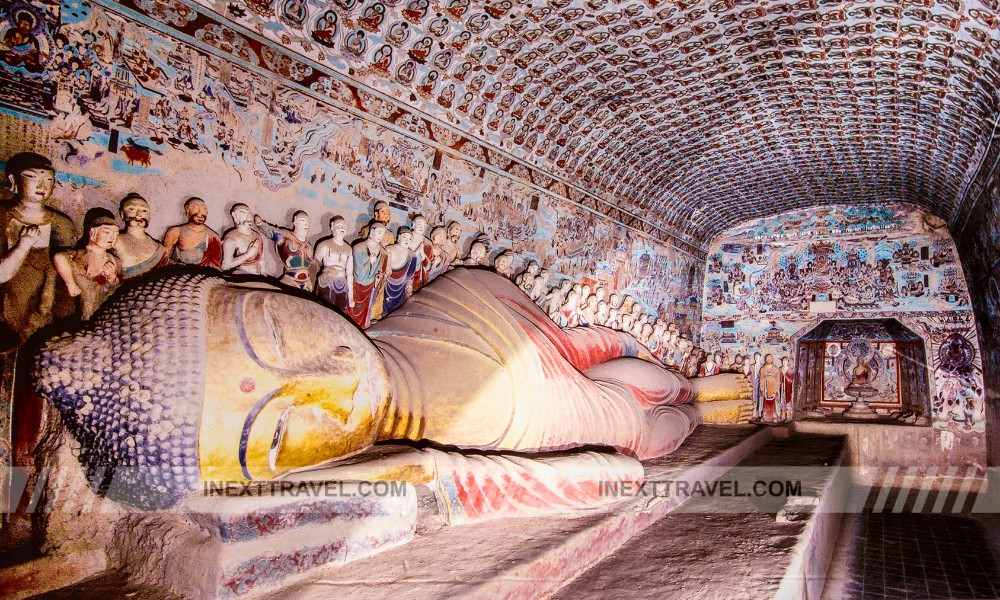
Beyond the artwork, the Mogao Caves offer a glimpse into the daily lives of those who lived and worked here. Explore the libraries, living quarters, and meditation halls, and imagine the bustling activity that once filled these cave dwellings.
A visit to the Mogao Caves is a journey of discovery and enlightenment. It’s a chance to immerse yourself in the rich history and artistic heritage of the Silk Road, to marvel at the intricate beauty of ancient artwork, and to connect with the spiritual traditions that have shaped this remarkable site for centuries.
Number 6: Lijiang Old Town, Yunnan.
Get lost in the enchanting maze of Lijiang Old Town, a UNESCO World Heritage Site nestled in the highlands of Yunnan province. With its winding cobblestone streets, traditional Naxi architecture, and intricate canal system, this ancient town offers a glimpse into a bygone era where time seems to slow down.
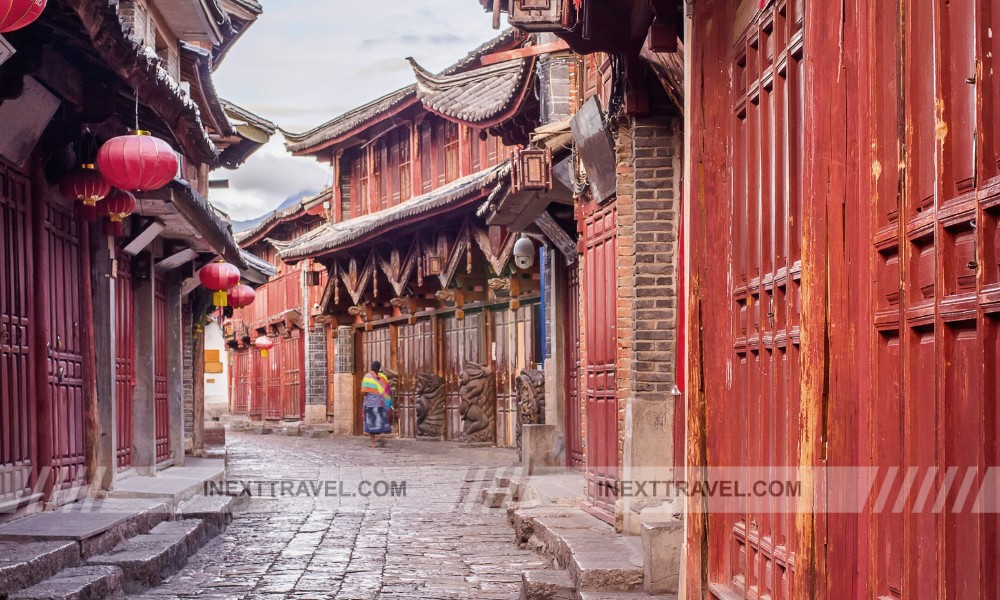
As you wander through the narrow alleyways, you’ll be captivated by the beautifully preserved wooden houses with their distinctive curved roofs and intricate carvings. The Naxi people, the region’s indigenous inhabitants, have a rich cultural heritage, evident in their architecture, music, and customs.
One of Lijiang’s most charming features is its network of canals, crisscrossing the town like veins. The sound of flowing water, the reflection of the ancient buildings in the canals, and the willows that drape over the banks create a peaceful and romantic atmosphere.
The central square, Sifang Street, is a bustling hub of activity where locals and tourists gather to shop, dine, and soak up the atmosphere. Here, you can find traditional crafts, local delicacies, and souvenirs to take home.
Beyond the central square, the old town is a maze of narrow streets and hidden courtyards, each with a unique charm. Explore the shops selling handcrafted jewelry, traditional clothing, and local artwork. Stop for a cup of tea at a traditional tea house or sample the local Naxi cuisine at one of the many restaurants.
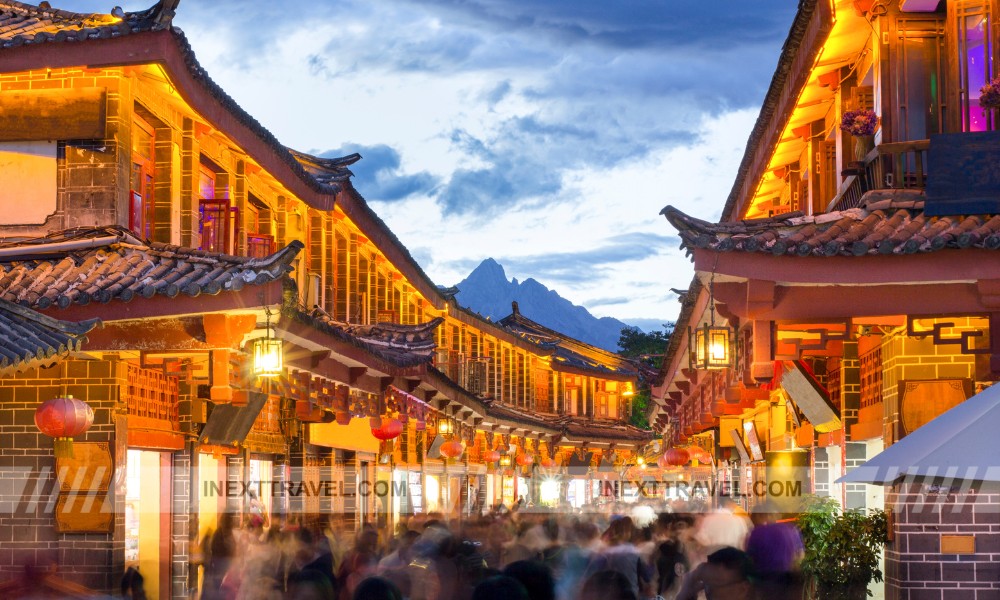
The old town comes alive in the evenings with music and laughter as locals and tourists gather in the bars and pubs to enjoy a lively atmosphere. Traditional Naxi music fills the air, adding to the town’s enchanting ambiance.
Lijiang Old Town is a place where you can immerse yourself in the rich culture and history of the Naxi people, wander through a maze of charming streets, and experience the unique atmosphere of this ancient town. It’s a destination that will leave you with lasting memories of its beauty, charm, and cultural richness.
Number 5: The Classical Gardens of Suzhou.
Escape the bustling pace of modern China and step into a world of tranquility and refined beauty at the Classical Gardens of Suzhou. This UNESCO World Heritage site, a collection of nine exquisite gardens, is a testament to the mastery of Chinese landscape architecture and the harmonious integration of natural and artificial elements.
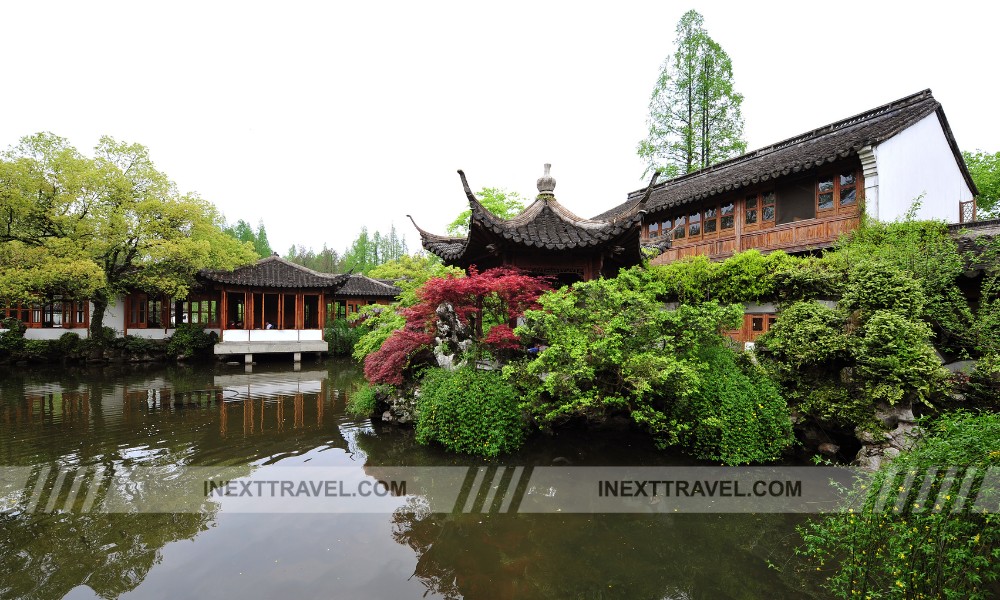
Each garden is a miniature world unto itself, carefully designed to evoke a sense of peace, balance, and harmony. Wander through winding paths that lead to hidden courtyards, tranquil ponds, and graceful pavilions. Admire the intricate rock formations, the delicate bonsai trees, and the vibrant flower beds that change with the seasons.
The Humble Administrator’s Garden, the largest and most renowned Suzhou gardens, is a masterpiece of landscape design. Its central lake, surrounded by pavilions, halls, and bridges, creates a picturesque scene that reflects the beauty of the surrounding landscape. The garden’s name, “the garden of the inept administrator,” is a playful reference to the owner’s desire to escape the stresses of official life and find solace in nature.
The Lingering Garden, another gem in the collection, is known for its exquisite rock formations and intricate water features. The garden’s central pond, dotted with islands and bridges, is a haven for koi fish and waterfowl. The pavilions, halls, and corridors surrounding the pond offer a variety of viewpoints from which to admire the garden’s beauty.
The Master of the Nets Garden, the smallest of the nine gardens, is a masterpiece of compact design. Its intricate layout, featuring a series of interconnected courtyards, pavilions, and ponds, creates an illusion of spaciousness and depth. The garden’s name refers to its former owner, a retired government official who sought to live a simple life as a fisherman.

The Classical Gardens of Suzhou are beautiful and a testament to China’s rich cultural heritage and philosophical traditions. The gardens reflect the principles of Feng Shui, the ancient Chinese art of harmonizing people with their environment. Each element of the garden, from the placement of rocks and trees to the flow of water and the design of the buildings, is carefully considered to create a balanced and harmonious environment.
Whether you’re seeking a peaceful retreat, a cultural immersion, or simply a chance to admire the beauty of Chinese landscape architecture, the Classical Gardens of Suzhou are a must-visit destination. They offer a unique glimpse into a world of tranquility and elegance, where you can escape the hustle and bustle of modern life and reconnect with nature and your inner self.
Number 4: The Giant Pandas of Chengdu.
No trip to China would be complete without a visit to Chengdu, the “Panda Capital of the World.” Get up close and personal with these adorable creatures at the Chengdu Research Base of Giant Panda Breeding, a sprawling sanctuary dedicated to conserving and preserving this beloved national treasure.

Stroll through the lush bamboo forests and sprawling enclosures, observing giant pandas in a habitat that closely mimics their natural environment. Watch them playfully tumble, munch on bamboo shoots, and doze off in the sun. Their playful antics and endearing expressions are sure to melt your heart.
The Chengdu Research Base is not just a zoo; it’s a leading center for giant panda research and conservation. Learn about the challenges facing this endangered species, the efforts to protect and increase their population, and the importance of preserving their natural habitat. Witness the dedication of the researchers and caretakers who work tirelessly to ensure the well-being of these gentle giants.

For a truly unforgettable experience, consider volunteering at the research base. You can help prepare food for the pandas, clean their enclosures, and participate in behavioral observation studies. It’s a unique opportunity to contribute to this iconic species’ conservation and learn firsthand about their fascinating lives.
Whether you’re a wildlife enthusiast, a nature lover, or someone who adores these adorable creatures, visiting the Chengdu Research Base is an experience you will never forget. It’s a chance to witness nature’s beauty and fragility, learn about the importance of conservation, and connect with one of the most beloved animals on the planet.
Number 3: The Karst Mountains of Guilin.
Embark on a mesmerizing journey along the Li River, where the enchanting karst mountains of Guilin create a landscape that seems to have sprung from a traditional Chinese painting. As you glide along the serene waters, you’ll be surrounded by a breathtaking panorama of towering limestone peaks that rise dramatically from the verdant landscape. These unique geological formations, sculpted by millennia of erosion, showcase nature’s artistry.
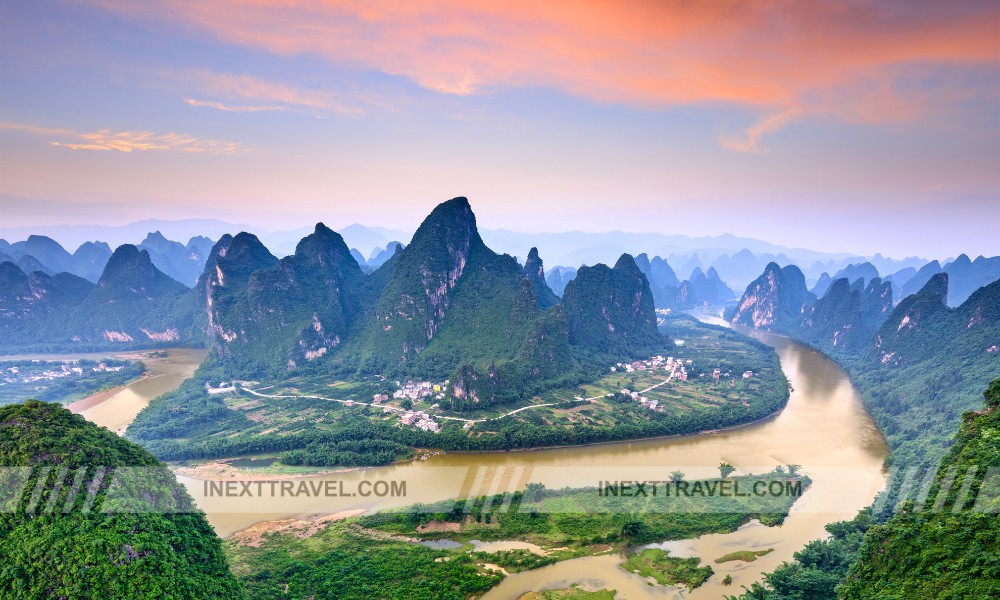
The karst mountains, with their jagged peaks, hidden caves, and lush vegetation, create a surreal and otherworldly atmosphere. The mist that often clings to the peaks adds a touch of mystery and ethereal beauty, while the mountains’ reflection in the calm water creates a mirror-like effect that is simply mesmerizing.
The scenery along the Li River constantly changes, offering a new and captivating vista at every turn. You’ll pass by charming villages nestled amidst the karst peaks, fishermen casting their nets in the tranquil waters, and bamboo rafts gliding gracefully along the river.

The karst landscape of Guilin has inspired artists and poets for centuries, and it’s easy to see why. The unique formations, the interplay of light and shadow, and the harmonious blend of nature and human activity create a truly captivating scene that will leave a lasting impression.
Whether you explore the Li River by boat, kayak, or bamboo raft, you’ll be treated to a visual feast of natural beauty and cultural heritage. Capture the stunning scenery with your camera, immerse yourself in the tranquil atmosphere, and let the Li River’s enchanting landscape transport you to a world of wonder and inspiration.
Number 2: The Terracotta Army, Xi’an.
Prepare to be astounded as we journey to the extraordinary Terracotta Army, an awe-inspiring archaeological wonder buried for centuries beneath the earth near Xi’an. This vast underground mausoleum complex, discovered in 1974 by local farmers, is a UNESCO World Heritage Site that continues to captivate visitors from around the globe.

Imagine entering a vast underground chamber and being greeted by an army of over 8,000 life-size terracotta warriors, each meticulously crafted with unique facial features, hairstyles, and armor. Standing in battle formation, these silent sentinels were created to protect China’s first emperor, Qin Shi Huang, in the afterlife. The sheer scale of this underground army is mind-boggling, a testament to the emperor’s ambition and power.
But the Terracotta Army is more than just a collection of statues. It’s a window into ancient Chinese civilization, offering insights into the military tactics, artistry, and social hierarchy of the Qin Dynasty. Each warrior’s unique facial expression and posture reveal a glimpse into their individual stories and personalities. The intricate details of their armor and weaponry showcase the advanced craftsmanship of the time.
The Terracotta Army Museum, built over the excavation site, allows you to witness this archaeological wonder up close. Wander through the vast pits where the warriors were unearthed, marvel at their lifelike appearance, and learn about the ongoing archaeological research that continues to uncover new secrets about this ancient army.

Beyond the warriors, the museum also displays a collection of bronze chariots and horses, as well as other artifacts that shed light on the life and times of Qin Shi Huang. Explore the exhibits, watch informative videos, and immerse yourself in the history and culture of ancient China.
The Terracotta Army is not just a historical site; it’s a testament to the enduring power of human creativity and ambition. It’s where the past comes alive, and you can witness firsthand the remarkable achievements of one of the most powerful empires in history.
Number 1: The Great Wall of China.
Our final destination is the awe-inspiring Great Wall of China, an enduring symbol of human ingenuity, perseverance, and the power of collective effort. This architectural marvel, stretching for thousands of miles across diverse landscapes, is a testament to the vision and determination of ancient Chinese civilizations.
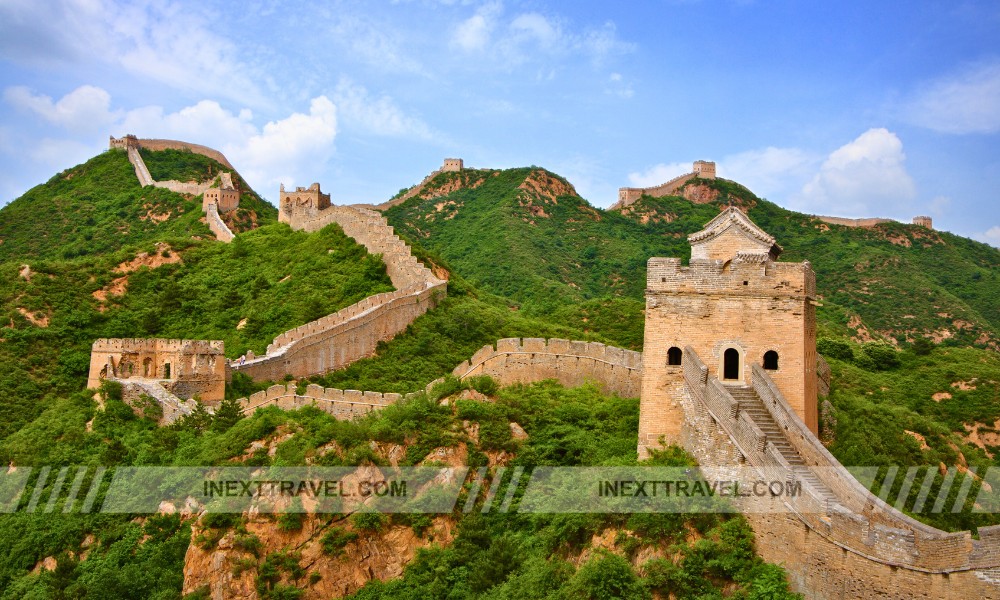
As you set foot on the Great Wall, you’ll be immediately struck by its sheer scale and grandeur. The imposing stone walls, winding along mountain ridges, plunging into valleys, and disappearing into the horizon, are a sight to behold. Feel the weight of history beneath your feet along its ancient pathways, and imagine the countless soldiers, merchants, and travelers who once traversed this legendary route.
The Great Wall is not a single continuous structure but a series of interconnected fortifications built over centuries by different dynasties. Each section boasts its unique architectural style and historical context. Explore the well-preserved sections near Beijing, such as Badaling, Mutianyu, and Jinshanling, which are known for their restored watchtowers, stunning views, and accessibility. For a more adventurous experience, venture to the wilder sections like Jiankou and Simatai, where crumbling ruins and overgrown vegetation add to the wall’s mystique.

As you hike along the Great Wall, take a moment to appreciate the breathtaking views that unfold before you. The landscape is as diverse as the wall, from rolling hills and lush valleys to rugged mountains and vast plains.
The Great Wall of China is not just a historical monument; it’s a living testament to human ingenuity and the enduring power of the human spirit. It’s a place where history comes alive, you can connect with the past, and you can experience the breathtaking beauty of China’s diverse landscapes. Whether you’re a history buff, an adventurer, or simply seeking a truly unforgettable experience, the Great Wall of China is a destination that will leave an indelible mark on your heart and soul.
Conclusion
China’s vastness and diversity offer many experiences, from the ancient wonders of the Great Wall to the bustling modernity of Shanghai and the tranquility of its classical gardens.
The 15 destinations we’ve explored are just a glimpse into this country’s treasures.
Each corner of China offers a unique blend of history, culture, and natural beauty, making it a destination that will leave an enduring mark on any traveler’s heart.
Whether you’re drawn to the spiritual tranquility of its temples, the vibrant energy of its cities, or the breathtaking landscapes that have inspired artists and poets for centuries, China promises a journey of discovery and wonder.
So, let this list be your starting point to explore the vast and diverse tapestry of experiences that await you in the Middle Kingdom.
Your adventure is just beginning!